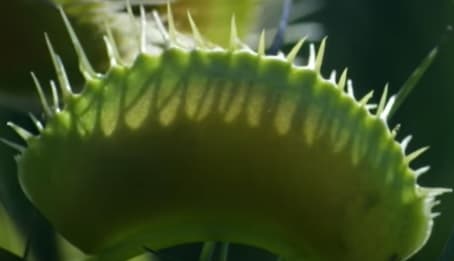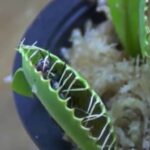As an Amazon Associate, this site earns commissions from qualifying purchases. For more details, click here.
Few plants hold our attention like the Venus flytrap. Watching a trapped insect struggle to escape, it makes you wonder just how strong these carnivorous plants are.
The force between two Venus flytrap lobe rims is 149 mN, and the rim pressure is 41kPa. In simple terms, their traps are very strong and small insects will have a hard time escaping.
Venus Flytrap Strength Explained
The following example demonstrates how powerful Venus flytraps are compared to insects.
As stated above, Venus flytrap strength has been measured as 149mN. 149 mN is 4 Newtons (N).
The average housefly can lift 1.5 times its own weight. These insects weigh 0.00007 kg, so it can lift 0.000012 kg.
0.000012 kg is equal to 0.00018816 N. The difference between 0.00018816 N and 4 Newtons is staggering.
If a housefly was a man capable of lifting 160 lbs., a Venus flytrap can lift at least a million pounds.
How Powerful are Venus Flytraps?
If you put your finger inside a Venus flytrap, it will attempt to close. It won’t hurt because the trap is too small. You can remove your finger without getting hurt.
Those sharp looking “teeth” aren’t sharp for humans. If you touch a Venus flytrap, you’ll realize those teeth or filaments are flexible.
So Venus flytraps are safe for humans and large animals. But for flies and other insects it’s a different story.
if we shrank to the size of insects, those filaments will look like bars in a jail. And that’s what these are for, trap insects, not eat them.
Do Venus Flytraps Have a Powerful Bite?
The traps look like mouths, but Venus flytraps don’t eat their prey. They don’t use the teeth to chomp on insects and swallow them.
Instead the teeth or filaments are used to lure and trap prey. If a fly falls into the trap, the filaments clamp down to prevent its escape.
The more the fly struggles, the tighter the trap gets. It’s possible for an insect to get crushed inside the trap.
Whether the fly gets crushed or not, the Venus flytrap will secrete digestive fluids to break the insect’s tissues down.
These fluids are harmless to humans and pets, but it is lethal to insects. The substance drowns insects and dissolves their body. This allows a Venus flytrap to absorb its nutrients.
This is what Venus flytraps do to all their prey. If you give them Orchid Gene food for instance, the plant will break it down first.
It takes several days for Venus flytraps to digest food. If its trap is not strong enough to hold the prey in, it might escape.

Can Venus Flytraps Get Stronger?
The average Venus flytrap has a diameter of 5 inches, with each trap growing to 1.5 inches. If you take care of a Venus flytrap it might grow up to 12 inches tall and produce 2 inch traps.
Most Venus flytraps can grow 10 traps at once, but some can produce up to 20. You shouldn’t feed them simultaneously though. One or two at a time is fine.
But can Venus flytraps get even bigger and stronger?
Venus flytraps cannot grow traps bigger than 2 inches. The plant evolved to trap and consume insects, so there’s no reason for it to grow bigger.
Venus flytraps are products of natural evolution. They evolved to eat insects because the soil they grow in lack nutrients.
To catch these insects, Venus flytraps developed traps. The size of each one is just right to catch bugs and absorb their nutrients.
If the traps were larger, small insects might escape. While larger, stronger traps can catch larger prey, it’s going to require more resources.
Venus flytraps use significant amounts of energy to produce and close traps. Digesting also consumes a lot of its resources.
If Venus flytraps preyed on larger creatures, it will also become prey to bigger hunters. As it is, large animals are threats to Venus flytraps.
Can Insects Escape a Venus Flytrap?
For flies and other small insects, it is almost impossible to escape. The hairs will squeeze tighter the more they try to get out, eventually triggering the digestive process.
Large bugs and other animals can easily escape though. In spite of their fearsome reputation, Venus flytrap traps are really small.
Venus flytraps can grow 5-10 traps simultaneously. Each trap is about 1-1.3 inches.
Most insects are 0.2 inches long, so they fit well in the trap. Other bugs like the Goliath Beetle and Hercules Moth are too large.
Worms, slugs and similar creatures can eat their way out of the trap. If a Venus flytrap somehow manages to partially catch and eat an earthworm, the part of its body not caught in the trap will rot. This can spread throughout the plant.
Are Venus Flytraps Strong Enough to Hurt You?
No. The traps of a Venus flytrap are stronger than most insects. But it is not capable of hurting humans. You can touch the trap or put your finger in it, you’ll be fine.
The only way Venus flytraps can hurt you is if you shrank to the size of a fly or the plant grows 20 feet. Other than that there is no way Venus flytraps can hurt people or large animals.
Pound for pound, its traps are powerful. But Venus flytraps as plants are quite fragile. They need special care and if not handled properly will die quickly.
Venus flytraps can grow strong traps in the right environment. In the wrong setting, Venus flytraps will die. Even if it lives, it won’t thrive.
Frequently Asked Questions
What is the strongest Venus flytrap?
Dionaea muscipula is the biggest Venus flytrap ever measured at 2.4 inches across. The Dionaea B52 trap grows up to 2 inches. The plant itself can reach 12 inches in diameter.
These sizes are possible in ideal circumstances. The plant won’t reach this size if there is not enough sunlight, water, food and temperature.
Are Venus flytraps strong enough to trap roaches, mice and frogs?
Most cockroaches are ½” to 5/8” long so yes, the plant can digest them. Adult Asian cockroaches are usually 1 inch long and American roaches twice as long so they’re too big.
Venus flytraps can only consume insects one third the size of its trap. Anything bigger and the plant will have a hard time digesting it.
Venus flytraps are strong enough to eat tiny frogs, but not mice. They are too large for a Venus flytrap. Other carnivorous plants like pitcher plants however, can trap and digest mice.
Are Venus flytraps strong enough to live without food?
Venus flytraps only eat every 1-2 weeks. Most of them will be fine eating bugs once a month.
Venus flytraps can and do photosynthesize, so they produce their own food. These plants trap insects to get nutrition lacking in the soil.
If Venus flytraps get enough sunlight, it can survive without eating bugs for a long time. It won’t thrive, but it will live. For optimum growth and strength, Venus flytraps must have both.
Can we genetically modify a Venus flytrap to be stronger and bigger?
Scientists have genetically modified Venus flytraps already, making them glow in the dark. But to make it larger and stronger is a different story.
Theoretically it is possible to make Venus flytraps 10 ft. tall, but there are challenges.
Venus flytraps evolved to catch small insects. You can’t just modify a few genes to make it physically larger. Its growth mechanisms have to be modified as well.
Assuming we have the technology to do that, the plant still won’t be a threat to humans. Even if it grows traps large enough to hold a human, you can tear through it. It’s still just leaves.
Do Venus flytraps get weaker as they age?
Venus flytraps can live up to 20 years. Their strength level doesn’t lessen with time, as it depends on the environment. If the environment is conducive to growth, the plant will continue to produce traps and live.

My fascination with carnivorous plants began many, many years ago with Venus Fly Traps. Now I am more than happy to impart what I know with other enthusiasts and those who are curious about meat eating plants.


